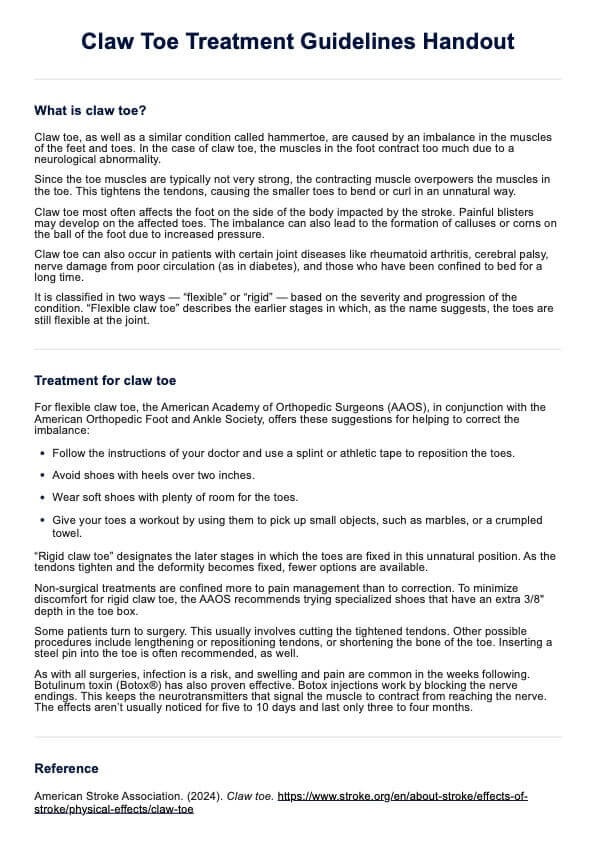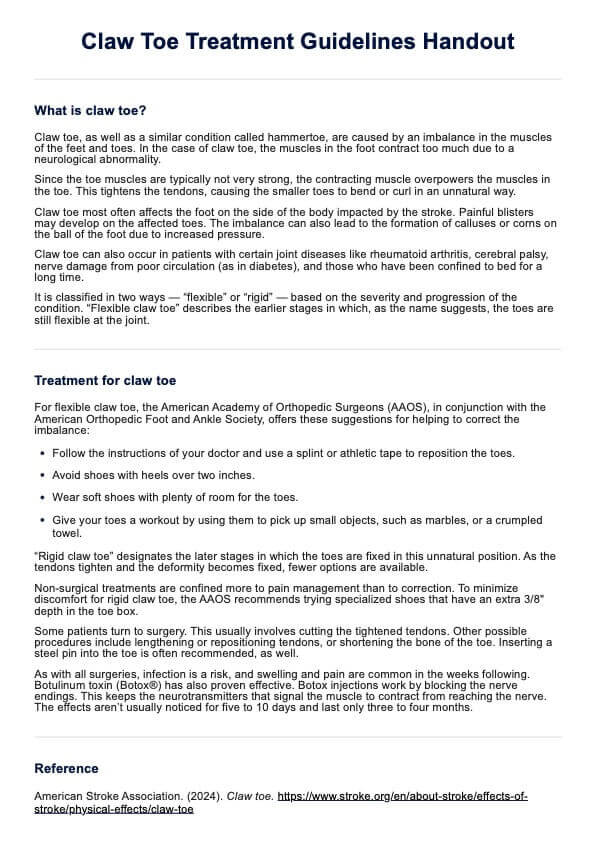Claw Toe Treatment Guidelines Handout
Discover effective claw toe treatment options to help you understand this condition better. Download Carepatron's free PDF guide for more information.


What is claw toe?
Claw toe is a condition where the toe joints contract, causing the toes to curl into a claw-like shape. This deformity occurs due to an imbalance in the toe muscles and tendons, often to developing claw toes. The condition is characterized by a bent toe joint, making the toes resemble claws. Claw toe deformity can affect one or more toes and is often linked to underlying health issues like rheumatoid arthritis, nerve damage, or diabetes.
The development of claw toes typically begins with the bending of the middle and end toe joints, causing discomfort and difficulty in walking. Individuals with claw toe may experience pain in the ball of the foot, especially when wearing shoes with inadequate room. To alleviate symptoms, it is crucial to wear shoes with roomy toe boxes and avoid tight shoes or high heels that exacerbate the condition.
Claw Toe Treatment Guidelines Handout Template
Claw Toe Treatment Guidelines Handout Example
Claw toe treatment options
Treatment options to address claw toe deformities vary depending on whether the condition is flexible or rigid.
Flexible claw toe
In the early stages of claw toe, when the affected toes can still be manually straightened, several conservative treatments can be effective:
- Repositioning aids: The American Academy of Orthopedic Surgeons (AAOS) recommends using splints or athletic tape to reposition the toes.
- Footwear modifications: Opt for shoes with heels under two inches and a soft, roomy toe box to comfortably accommodate your toes.
- Toe exercises: Strengthen toe muscles by practicing picking up small objects like marbles or a crumpled towel with your toes.
Rigid claw toe
As the condition progresses, the toes may become fixed in the claw position, limiting treatment options:
- Specialized footwear: The AAOS suggests trying shoes with an extra 3/8" depth in the toe box to minimize discomfort.
- Pain management: Non-surgical treatments at this stage focus more on managing pain than correcting the deformity.
- Surgical interventions: When conservative measures fail, surgery may be considered. Options include tendon release or cutting the tightened tendons to allow for better toe positioning. Practitioners may also opt to do tendon lengthening or repositioning, bone shortening, and toe stabilization.
- Botulinum toxin injections: Botox® has shown effectiveness in some cases. It works by blocking nerve signals that cause muscle contraction.
It's important to note that surgical procedures carry risks such as infection, and patients often experience swelling and pain in the weeks following surgery. The choice of treatment should be based on individual patient factors and made in consultation with a healthcare provider.
How to use our treatment guidelines handout template?
Carepatron's Claw Toe Treatment Guidelines Handout is designed to assist healthcare professionals in effectively managing and educating patients about claw toe. Here’s how medical professionals can use this valuable resource:
Access and download the handout
To begin, access the Carepatron platform and download the claw toe treatment handout template. You can also download a PDF copy through the preview of the handout on this page.
Review the treatment guidelines
Once downloaded, thoroughly review the treatment guidelines included in the handout. The template provides detailed information on treatment options to correct claw toe.
Introduce the handout and educate the patient
During the consultation, introduce the handout to the patient. Explain the importance of each treatment step, including wearing shoes with roomy toe boxes, avoiding high heels and tight shoes, and performing exercises to stretch the toes and strengthen foot muscles.
Monitor progress and follow-up
Use the handout to monitor the patient’s progress over time. Schedule regular follow-up appointments to assess improvements and make any necessary adjustments to the treatment plan.
How can healthcare professionals benefit from our template?
Healthcare professionals can greatly benefit from Carepatron's Claw Toe Treatment Guidelines Handout by streamlining patient care and improving treatment outcomes. This template offers a structured approach to managing deformed claw toes, ensuring practitioners can access up-to-date and comprehensive treatment guidelines.
With this handout, healthcare professionals can save time on documentation and focus more on patient interaction and care. The template also helps maintain consistency in treatment protocols, reducing the risk of errors and enhancing patient education.
Additionally, it includes practical tips and exercises that patients can follow at home, promoting better adherence to treatment plans. Overall, this handout supports healthcare providers in delivering efficient, effective, patient-centered care.
Commonly asked questions
Yes, claw toes can be corrected with non-surgical treatments such as wearing properly fitting shoes, using orthotic devices, and performing specific exercises. A claw toe surgery like tendon lengthening or toe fusion may be necessary in severe cases.
Claw toe is caused by an imbalance in the claw toe muscles and tendons, often due to underlying conditions such as rheumatoid arthritis, nerve damage, or diabetes. Wearing tight shoes or high heels can also contribute to developing claw toes.
Exercises for claw toe include toe stretches and strengthening exercises, such as picking up small objects with your toes or using resistance bands. These exercises help improve flexibility and strengthen the foot ball to correct the deformity.
A hammer toe has a bend in the middle joint of the toe, causing it to resemble a hammer. In contrast, a claw toe involves a bend in the middle and end joints, making the toe curl into a claw-like shape.







































































































